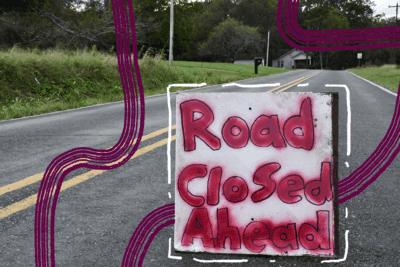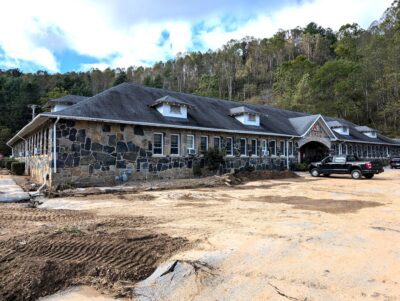
As the recovery effort continues nearly one year after Hurricane Helene hit western North Carolina, state leaders said that almost 75% of the region’s $59.6 billion total estimated financial need is unfunded.
During a Hurricane Response and Recovery Subcommittee hearing at the General Assembly on Wednesday, state and local government officials detailed holdups with federal funding and attributed delays to the Federal Emergency Management Agency (FEMA).
According to a presentation to the committee by Matt Calabria, director of the Governor’s Recovery Office for Western North Carolina (GROW NC), about $14.9 billion in recovery funding is allocated or expected, leaving $44.7 billion in unfunded needs.
Currently, nearly $3.1 billion in state funds, $5.2 billion in federal funds, and $6.7 billion in expected insurance and other funding has been used or is designated for recovery, according to the presentation. Calabria said the federal funding North Carolina has received is not enough, and that it’s coming down too slowly.
![]() Sign up for the EdDaily to start each weekday with the top education news.
Sign up for the EdDaily to start each weekday with the top education news.
FEMA causing delays for local governments
Dennis Aldridge, county commissioner of Avery County, said his county has received $15 million through FEMA’s Individual Assistance Program, “which sounds wonderful until you start dividing it by the 5,000 people, and that’s about $3,000 a person.”
Most other FEMA assistance, he said, has so far gone unapproved or unreimbursed.
“Moving forward, our biggest obstacle is the lack of clarity and consistent guidance from FEMA,” Aldridge said. “Every time we get close to the finish line, they change the goalposts.”

One FEMA program raised as an example of the agency’s inefficiency is the Hazard Mitigation Grant Program (HMGP), which funds the government buyout of homes that are no longer livable after a disaster like Helene.
Homeowners fill out an application to their local government, which applies to the state, which then applies to FEMA for approval.
The program reimburses the state for the buyouts, but requires FEMA approve applications before the state can act.
HMGP applications were submitted as long ago as February. So far, not a single Helene-related application for a home buyout has been approved, leaving hundreds of families in limbo — in some cases, paying mortgages on damaged houses or being held in abeyance, Calabria said.
“We would love for them to say no, because then we can move on to other solutions,” said Jonathan Krebs, western North Carolina recovery advisor to Gov. Josh Stein.
Those HMGP applications are also subject to review by Homeland Security Secretary Kristi Noem, under a directive requiring her personal approval for any Department of Homeland Security expenditure over $100,000.
“I don’t even think they recognize the scope of it, ” said Sen. Ralph Hise, R-Mitchell, in reference to the directive. “Hopefully the work week’s a little longer for the Secretary.”
Calabria said the HMGP issue is indicative of broader difficulties applying for federal aid.
“I think it’s a good exemplar for the kinds of dynamics that we’re running into with the federal government right now,” Calabria said. “It’s keeping us up at night, and we are doing everything we can to push as zealously for the interest of western North Carolina’s residents as we can.”
Other roadblocks to receiving federal aid
According to the presentation submitted to the committee, other delays in the federal funding process have come from the Department of Government Efficiency (DOGE), which can place up to months-long holds on applications through its Defend the Spend program.
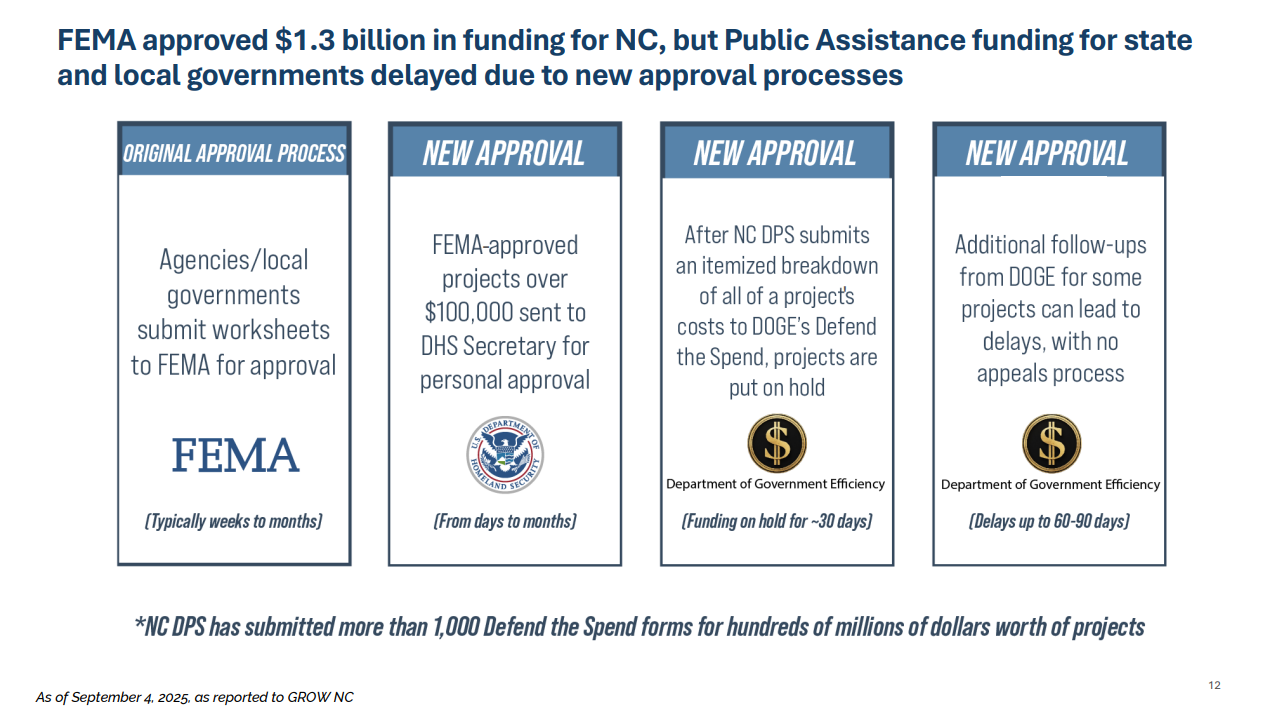
Various debris pickup FEMA programs have also left local officials in a bad position, officials said. Massive amounts have been cleared — over a million cubic yards of vegetative debris in Avery County, for example — but the tens of millions of dollars districts have spent has not yet been reimbursed by FEMA.
“Unfortunately, that’s cost us $53 million,” Aldridge said. “Our total county budget is $42 million. So, that math don’t math.”
Lynn Austin, county manager of Yancey County, said FEMA has “really put the bottleneck down” on what debris removed from private property is eligible for reimbursement.
“Some folks, 80, 90 years old, they’ve got huge debris piles. There’s no way they can afford to get those moved, and there’s no way they can physically do it themselves,” she said.
Both Austin and Aldridge noted that remaining debris on the ground poses a fire risk as fall approaches. That could be compounded by limited access by firefighting crews due to remaining road closures, they said.
Helene federal funding compared to past disasters
Luther Harrison, representing Samaritan’s Purse, recounted the work his organization has done directly administering aid in western North Carolina, including building new homes for displaced residents.
“This one is ranking up there with the Sandys, the Katrinas, the Harveys,” he said.
However, there is a disparity in the level of federal funding North Carolina has received so far for Helene compared to other states in previous hurricanes, like Hurricane Sandy and Hurricane Katrina. According to the GROW NC presentation, 78% of hurricane economic damage after Sandy, and 73% after Katrina, was covered by federal aid.
So far, just 10.6% has been covered by federal aid for Helene. (On Monday, the U.S. Department of Transportation announced additional relief funding, raising the total from 9% on the chart below to 10.6%.)
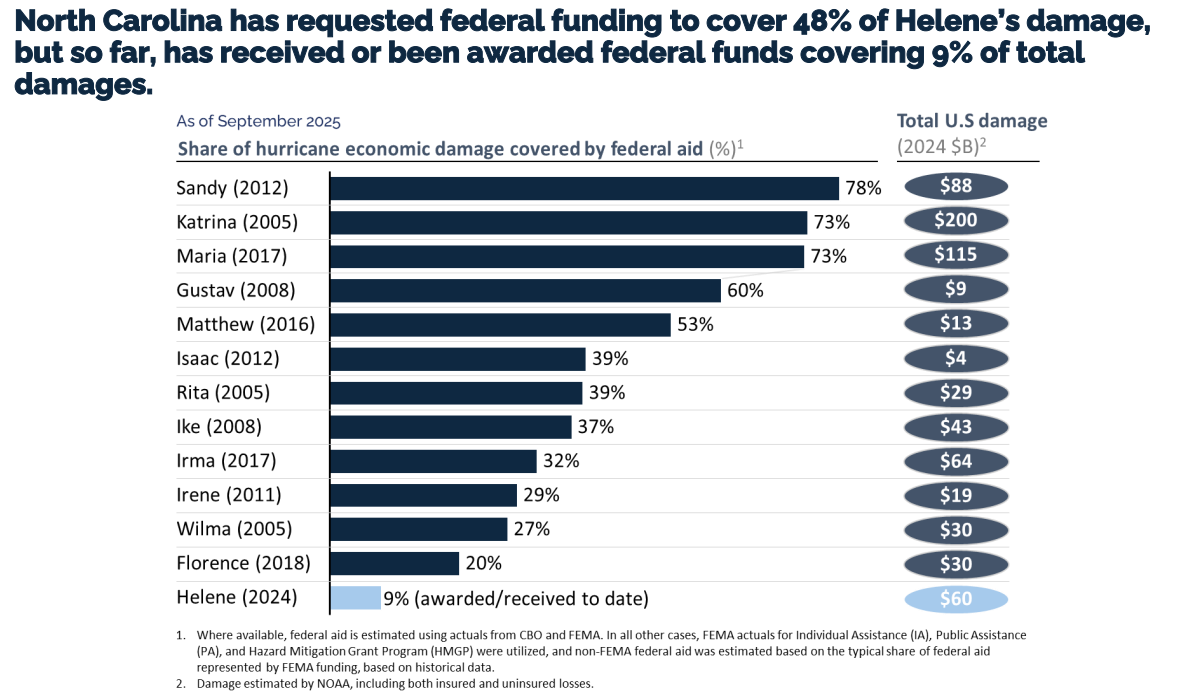
Last week, Stein traveled to Washington, D.C., to meet with North Carolina’s congressional delegation and Office of Management and Budget Director Russ Vought to advocate for increased aid to the state.
“It’s been nearly a year since Hurricane Helene, and while we are grateful for every dollar of federal support we have received, we need more,” he said. “I was pleased to meet with the Trump administration and members of our Congressional delegation to advocate for an additional $13.5 billion to strengthen western North Carolina’s recovery, getting folks back in their homes, boosting small businesses, supporting local governments, and repairing critical infrastructure.”
The broader context of FEMA
Stein has also recommended specific reforms to FEMA, like an initial block grant after disasters and moving away from reimbursement models to better support local governments.
President Donald Trump, in contrast, has previously said more responsibility should be on states after disasters and called for the elimination of FEMA altogether.
Meanwhile, a bipartisan bill introduced in Congress earlier this year would reform FEMA by making it a Cabinet-level agency, funneling all aid requests through a single application, and incentivizing mitigation projects.

State Treasury interest-free cash loan program relies on FEMA
Massive expenditures, even those that should be reimbursed by federal aid, are a problem for local governments with small fund balances — like Avery County, where debris pickup costs exceeded the county’s annual budget.
Seeking to preempt county fund balance problems, the Department of State Treasurer has offered three rounds of interest-free cash flow loans to local government units, funded by the General Assembly’s disaster recovery acts.
“We needed to know that whatever funds we sent to local governments, that they had well more than that in damage estimates as FEMA reimbursements,” said State Treasurer Brad Briner. “Once we had satisfied ourselves that that was the case for every local government, we flipped the conventional application process upside down. We presumed the local government qualified for these funds and wanted them as a default.”
That led to 100% of $150 million in state allocated funds to be loaned in the past eight months.
“Simplicity leads to expediency,” Briner said.
Briner told the committee his department estimated an additional $850 million in need for the program.
Read about the General Assembly’s Helene relief bills
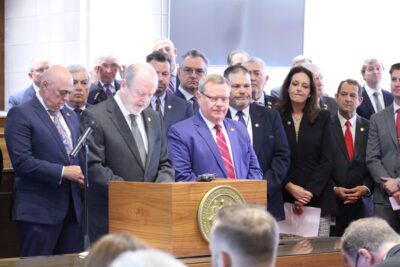
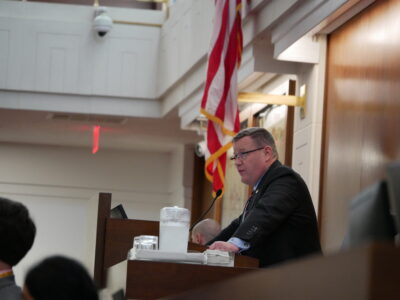

Strategies moving forward
In response to hearing about the difficulties receiving federal aid, some lawmakers on the committee floated the idea of more state funding.
Sen. Julie Mayfield, D-Buncombe, said, regarding the HMGP home buyouts: “If it’s money that we have in reserve somewhere, or that we can appropriate that would make all of this move faster and take better care of the people of western North Carolina, then I’m all for it, even if it means sacrificing federal dollars.”
Rep. Zack Hawkins, D-Durham, inquired about the feasibility of expanding the cash flow loan program.
Rep. Brenden Jones, R-Columbus, asked if the state should be funding non-governmental groups like Samaritan’s Purse directly, because they can move faster and circumvent “bureaucracy and the red tape.”
Calabria noted similar organizations are already funded with state dollars, although Samaritan’s Purse specifically chose not to accept state funds.
“I want to get to the question of how much you need,” Hise said to the county officials. “If we have funds sitting there that are going to be paid back by the feds, there’s no reason for you to continue that burden as counties. And so we can put that money out and receive it back, whenever FEMA gets off their derrière.”
Aldridge and Austin each asked the committee for between $8-15 million for their county in a potential next round of state disaster relief.
“I’m glad to hear from our local leaders. I know that we’re celebrating what’s open, but we’re not finished, and in many ways, we’re just getting started,” Hise said. “And western North Carolina still needs a lot of support from this state.”
Recommended reading

